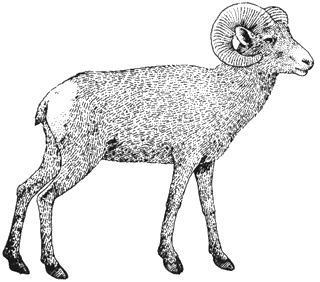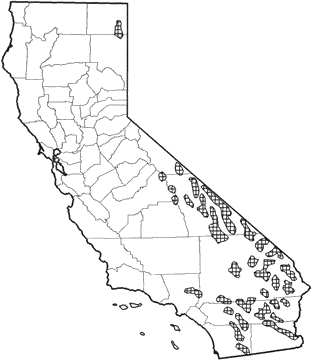
Bighorn Sheep
Distribution, Abundance, and Seasonality
Mostly uncommon in California. Three subspecies occur: California bighorn sheep (O. c. californiana), peninsular bighorn sheep (O. c. cremnobates), and Nelson bighorn sheep (O. c. nelsoni). Up to 1979, California bighorns consisted of 2 native herds in the southern Sierra Nevada (Mt. Baxter and Mt. Williamson herds). Subsequently, Mt. Baxter herd has been used as a source for reintroductions, into Inyo Co., and into the South Warner Wilderness (Modoc Co.). Peninsular bighorns occur in the Peninsular Ranges from the San Jacinto and Santa Rosa Ranges (Riverside Co.) south into Mexico. Nelson bighorns (also called desert bighorns) occur in desert mountain ranges from White Mts. of Mono and Inyo cos., south to San Bernardino Mts., thence southeastward to the Mexican border. An isolated population occurs in the San Gabriel Mts. Habitats used include alpine dwarf-shrub, low sage, sagebrush, bitterbrush, pinyon-juniper, palm oasis, desert riparian, desert succulent shrub, desert scrub, subalpine conifer, perennial grassland, montane chaparral, and montane riparian (DeForge 1980, Monson and Sumner 1980, Wehausen 1980).

Range Map
Specific Habitat Requirements
Feeding: Graze and browse on a wide variety of plant species. Green, succulent grasses and forbs are preferred; browse is important all year, especially for populations in arid habitats. Some populations use mineral licks, and some may be limited by phosphorus. Feed in open habitats, such as rocky barrens, meadows, and low, sparse brushlands (Dunaway 1972, Monson and Sumner 1980, Wehausen 1980, Ginnett and Douglas 1982, Lawson and Johnson 1982).
Cover: Use rocky, steep terrain for escape and bedding. Remain near rugged terrain while feeding in open habitat.
Reproduction: Use steep, rugged slopes and canyons for lambing areas (Wehausen 1980).
Water: Water is critical in arid regions. Use springs, water in depressions, and human-made sources. The latter are significant means of enhancing habitat (Leslie and Douglas 1979).
Pattern: Prefer open areas of low-growing vegetation for feeding, with close proximity to steep, rugged terrain for escape, lambing, and bedding, an adequate source of water, and travel routes linking these areas.
Species Life History
Activity Patterns: Active yearlong; mostly diurnal activity. Move to bedding areas at night. Bad weather may restrict activity. Desert sheep are least active during the hot midday, when they remain near water (Lawson and Johnson 1982).
Seasonal Movements / Migration: Migrate between winter and summer ranges. Montane populations spend the summer in alpine habitats, moving downslope into canyons in winter. Desert bighorns are restricted to the vicinity of water during the hot summer, dispersing at other times of year (Leslie and Douglas 1979, Monson and Sumner 1980, Wehausen 1980, Tilton and Willard 1982, Wehausen 1983).
Home Range: Home range includes summer and winter ranges and routes of travel between. Winter range generally is smaller, but desert bighorns have smaller ranges in summer because of water restrictions. Sheep in Yellowstone National Park moved 3-5 km (2-3 mi)/day in summer. Welles and Welles (1961) reported desert bighorns remained within a radius of 32 km (19 mi) during their lifespan.
Territory: There is no territorial defense. Groups of ewes stay in distinct ranges, with little interchange between groups. Rams may travel between groups, particularly during the rut (Geist 1971, Lawson and Johnson 1982).
Reproduction: Polygamous. Rutting occurs in November and December in northern populations, and may be yearlong for desert bighorns, peaking in August and September. Gestation is 5.5-6.0 mo. Lambing season is mid-April to early June, depending on conditions. Desert bighorns may give birth at any time, but most births occur from January to April. Twins are rare. Ewes reach sexual maturity at 2.5 yr, possibly as yearlings under good conditions. Rams reach sexual maturity at the same age, but are unlikely to mate until larger. A recruitment rate of 25-30 lambs/100 ewes is common in static populations.
Niche: Extremely sensitive to disease. A herd at Lava Beds National Monument was lost to pneumonia in 1980. Diseases, particularly those of livestock, may be the major factor in decline and loss of populations. Feral ungulates and livestock compete with desert bighorns for water, and may compete for forage. Predation may be an important loss in very small populations, such as recent transplants. Loss of any critical habitat (e.g., lambing and feeding areas, escape terrain, water sources, travel routes) also may result in serious decline or loss of populations (Hicks and Elder 1979, Jessup 1981, Seegmiller and Ohmart 1981, DeForge et al. 1982, DeForge and Scott 1982, Dunn and Douglas 1982, Ginnett and Douglas 1982, Wehausen 1983, Shackleton 1985).
Comments: Under special legislation, a few Nelson bighorn rams were harvested beginning in 1987.
Sources & References
California Department of Fish and Game, 1999.
California's Wildlife, Sacramento, CA.
Written by: R. A. Hopkins, reviewed by: H. Shellhammer, edited by: J. Harris, R. Duke
Buechner, H. K. 1960. The bighorn sheep in the United States, its past, present, and future. Wildl. Monogr. No. 4. 174pp. DeForge, J. R. 1980. Population biology of desert bighorn sheep in the San Gabriel Mountains of California. Desert Bighorn Counc. Trans. 24:29-32. DeForge, J. R., and J. E. Scott. 1982. Ecological investigations into high lamb mortality. Desert Bighorn Counc. Trans. 26:65-76. DeForge, J. R., J. E. Scott, G. W. Sudmeier, R. L. Graham an S. V. Segreto. 1982. The loss of two populations of desert bighorn sheep in California. Desert Bighorn Counc. Trans. 26:36-38. Dunaway, D. J. 1972. Winter food habits of California bighorn sheep in the Sierra Nevada. Desert Bighorn Counc. Trans. 16:21-29. Dunn, W. C., and C. L. Douglas. 1982. Interactions between desert bighorn sheep and feral burros at spring areas in Death Valley. Desert Bighorn Counc. Trans. 26:87-96. Geist, V. 1971. Mountain sheep: a study in behavior and evolution. Univ. Chicago Press, Chicago, IL. 383pp. Ginnett, T. F., and C. L. Douglas. 1982. Food habits of feral burros and desert bighorn sheep in Death Valley National Monument. Desert Bighorn Counc. Trans. 26:81-87. Hicks, L. L., and J. M. Elder. 1979. Human disturbances of Sierra Nevada bighorn sheep. J. Wildl. Manage. 43:909-915. Jessup, D. A. 1981. Pneumonia in bighorn sheep: effects on populations. Cal-Neva Wildl. 1981:72-78. Lawson, B., and R. Johnson. 1982. Mountain sheep. Pages 1036-1055 in J. A. Chapman, and G. A. Feldhamer, eds. Wild mammals of North America. Johns Hopkins Univ. Press, Baltimore, MD. 1147pp. Leslie, D. M., Jr., and C. L. Douglas. 1979. Desert bighorn sheep of the River Mountains, Nevada. Wildl. Monogr. No. 66. 56pp. Monson, G., and L. Sumner, eds. 1980. The desert bighorn: its life history, ecology, and management. Univ. Arizona Press, Tucson. 370pp. Seegmiller, R. F., and R. D. Ohmart. 1981. Ecological relationships of feral burros and desert bighorn sheep. Wildl. Monogr. No. 78. 58pp. Shackleton, D. M. 1985. Ovis canadensis. Mammal. Species No. 230. 9pp. Tilton, M. E., and E. E. Willard. 1982. Winter habitat selection by mountain sheep. J. Wildl. Manage. 46:359-366. Wehausen, J. D. 1980. Sierra Nevada bighorn sheep: history and population ecology. Ph.D. Diss. Univ. Michigan, Ann Arbor. 240pp. Wehausen, J. D. 1983. White Mountain bighorn sheep: an analysis of current knowledge and management alternatives. USDA, For. Serv., Inyo Nat. For. Bishop, CA. Adm. Rep., Contract No. 53-9JC9-0-32. 93pp. Welles, R. E., and F. B. Welles. 1961. The bighorn of Death Valley. USDI, Natl. Park Serv., Fauna Ser. No. 6. 242pp.
California Animal Facts | California's Wildlife